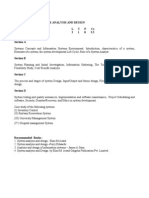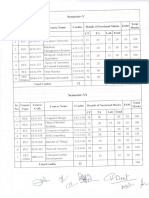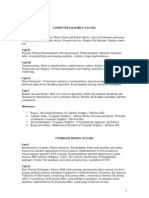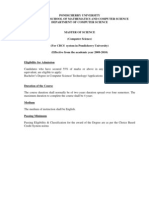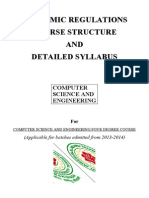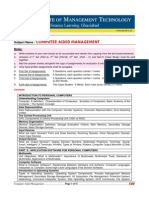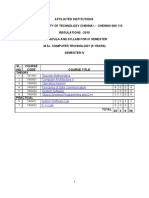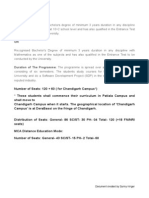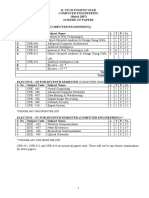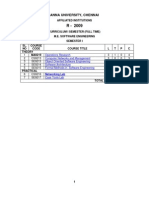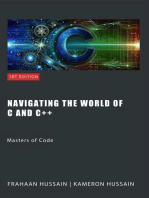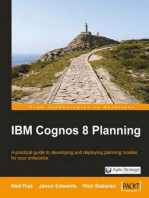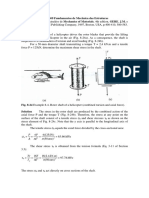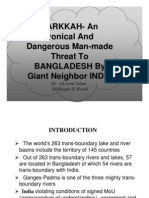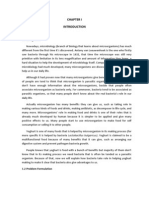B.Tech Sem6 Ucoe
B.Tech Sem6 Ucoe
Uploaded by
Raghav BhandariCopyright:
Available Formats
B.Tech Sem6 Ucoe
B.Tech Sem6 Ucoe
Uploaded by
Raghav BhandariOriginal Description:
Original Title
Copyright
Available Formats
Share this document
Did you find this document useful?
Is this content inappropriate?
Copyright:
Available Formats
B.Tech Sem6 Ucoe
B.Tech Sem6 Ucoe
Uploaded by
Raghav BhandariCopyright:
Available Formats
B.
TECH THIRD YEAR
COMPUTER ENGINEERING
(Batch 2012)
Session (2014-15)
SCHEME OF PAPERS
SIXTH SEMESTER (COMPUTER ENGINEERING)
S.
Subject Code Subject Name
No.
1.
CPE-307
RDBMS using SQL and PL/SQL
2.
CPE-308
Computer Graphics
3.
CPE-309
Compiler Design
4.
CPE-310
DotNet Programming
5.
CPE-357
Relational Database Management System Lab
6.
CPE-358
Computer Graphics Lab
7.
CPE-360
DotNet Programming Lab
8.
Elective-II *
9.
Elective-III **
Total
Total Contact Hours = 30
ELECTIVE II FOR SIXTH SEMESTER (COMPUTER ENGINEERING)*
S.
Subject Code Subject Name
No.
1
CPE-311
Parallel Computing
2
CPE-312
Multimedia Systems
1.
CPE-313
Software Project Management
2.
CPE-314
Distributed Computing
3.
MBA-5011
Foundation of Financial Accounting
*CHOOSE ANY ONE FROM THE LIST
T P Cr.
3
3
3
3
0
0
0
3
3
18
1
1
1
1
0
0
0
1
1
6
T P Cr.
3
3
3
3
3
1
1
1
1
1
ELECTIVE III FOR SIXTH SEMESTER (COMPUTER ENGINEERING)**
S.
Subject Code Subject Name
L
No.
1.
CPE-315
Network Security
3
2.
CPE-316
ATM Networks
3
3.
CPE-317
Grid Computing
3
4.
CPE-318
Business Intelligence
3
5.
MBA-5012
Foundations of Managerial Accounting
3
**CHOOSE ANY ONE FROM THE LIST
0
0
0
0
2
2
2
0
0
6
0
0
0
0
0
3.5
3.5
3.5
3.5
1.0
1.0
1.0
3.5
3.5
24
3.5
3.5
3.5
3.5
3.5
T P Cr.
1
1
1
1
1
0
0
0
0
0
3.5
3.5
3.5
3.5
3.5
CPE-357, CPE-358 and CPE-360 are practical papers only. There will not be any theory
examination for these papers.
CPE-307
RDBMS using SQL and PL/SQL
L
Cr
3.5
Section A
Introduction of DBMS:
Types of DBMS and their advantages and disadvantages, DBMS architecture, Enhanced-ER
(EER) Model Concepts, EER-to-Relational Mapping, Data Abstraction and Knowledge
embedded SQL, Query by example.
Distributed Databases and Client-Server Architecture: Introduction to Distributed DBMS
Concepts, Client-Server Architecture Overview, Data Fragmentation, Replication, and Allocation
Techniques for Distributed Database Design, Types of Distributed Database Systems.
Database Security: Types of Security, Control Measures, DB security and DBA, Access
protection, Discretionary Access Control based on granting and revoking privileges
Section B
Overview of SQL:
Introduction to SQL Server and Oracle Server. Select, Insert, Update, Delete Commands
Inbuilt function (string, numeric and date), joins, create table and constraints, Data Dictionary,
views, Grant Revoke
Section C
PL/SQL: Block structure, data types, creation of variable, scope, nested blocks, control
structures, cursors and its types
Section D
Procedures and types of parameter passing
Functions both inbuilt and user defined
Packages both user defined and inbuilt
Triggers and its types
Recommended Books :
1. Navathe and Elmasri, Fundamentals of Database Systems, Pearson education
2. Korth and Silberschatz Abraham, Database Concepts, McGraw Hall, 1991.
3. An introduction to database system by C.J.Date (Addison Welsey, Publishing house) Latest
edition.
4. Bipin Desai, Database System, TMG
5. Prateek Bhatia, Database Management system, Kalyani Publishers
CPE-308
COMPUTER GRAPHICS
L
3
T
1
P
0
Cr
3.5
Section-A
Raster CRTs, Raster and Random Scan Displays, Display
Controllers and Processors, Graphics Input Devices, Applications of Computer Graphics.
RASTER SCAN CONVERSION ALGORITHMS: Line Drawing Algorithms (DDA &
Bresenhams), Circle Drawing Algorithms (Mid Point and Bresenhams).
GRAPHICS HARDWARE:
Section-B
Basic Transformations,
(Translation, Rotation and Scaling) Matrix Representation and Homogenous Coordinates, Shear
and Reflection Transformations, Composite Transformations.
FILLING: Region filling Algorithms (Boundary Fill and Flood Fill).
TWO-DIMENSIONAL
GEOMETRIC
TRANSFORMATIONS:
Section-C
WINDOWING AND CLIPPING: Viewing pipeline, viewing transformations. 2-D Clipping
algorithms- Line clipping algorithms (Cohen Sutherland, Liang Barsky algorithm) Polygon
clipping (Sutherland Hodgeman polygon clipping, Weiler and Atherton polygon clipping).
THREE-DIMENSIONAL GEOMETRIC TRANSFORMATIONS: Basic Transformations:
(Translation, Scaling, Rotation) Composite transformations.
Section-D
PROJECTIONS: Parallel and Perspective.
VISIBLE SURFACE DETECTION METHODS: Depth Buffer Method, A-Buffer Method, Scan
Line Method, Area Subdivision Method.
Shading: Gouraud and Phong Shading Algorithms, Properties of Bezier and B-Spline Curves.
Recommended Books:
1. Computer Graphics: By Donald Hearn, M. Pauline Baker
2. Computer Graphics (Schaum Series ) by Lipschutz (MC Graw Hill)
3. Principles of Interactive Computer graphics: By W.M. Newman, R.Sproull
4. Fundamentals of Interactive Computer Graphics: By J.D. Foley, A. Van Dam
5. Computer Graphics Using OPEN GL: By F.S. Hill Jr.
6. Computer Graphics: Roy A. Plastock, Gordon Kalley.
CPE - 309
COMPILER DESIGN
L
3
T
1
P
0
Cr
3
Section A
INTRODUCTION TO COMPILING:
Compilers Analysis of the source program Phases of a compiler Cousins of the Compiler
Grouping of Phases Compiler construction tools Lexical Analysis Role of Lexical Analyzer
Input Buffering Specification of Tokens.
Section B
SYNTAX ANALYSIS: Role of the parser Writing Grammars Context-Free Grammars Top
Down parsing Recursive Descent Parsing Predictive Parsing Bottom-up parsing Shift
Reduce Parsing Operator Precedent Parsing LR Parsers SLR Parser Canonical LR Parser
LALR Parser.
Section C
INTERMEDIATE CODE GENERATION: Intermediate languages Declarations Assignment
Statements Boolean Expressions Case Statements Back patching Procedure calls.
Section D
CODEGENERATION: Issues in the design of code generator The target machine Runtime
Storage management Basic Blocks and Flow Graphs Next-use Information A simple Code
generator DAG representation of Basic Blocks Peephole Optimization.
CODE OPTIMIZATION AND RUN TIME ENVIRONMENTS: Introduction Principal Sources
of Optimization Optimization of basic Blocks Introduction to Global Data Flow Analysis
Runtime Environments Source Language issues Storage Organization Storage Allocation
strategies Access to non-local name Parameter Passing.
Recommended Books :
1. Alfred Aho, Ravi Sethi, Jeffrey D Ullman, Compilers Principles, Techniques and Tools,
Pearson Education Asia, 2003.
2. Allen I. Holub Compiler Design in C, Prentice Hall of India, 2003.
3. C. N. Fischer and R. J. LeBlanc, Crafting a compiler with C, Benjamin Cummings,
2003.
4. J.P. Bennet, Introduction to Compiler Techniques, Second Edition, Tata McGraw-Hill,
2003.
5. Henk Alblas and Albert Nymeyer, Practice and Principles of Compiler Building with
C, PHI, 2001.
6. Kenneth C. Louden, Compiler Construction: Principles and Practice, Thompson
Learning, 2003
CPE-310
DotNet Programming
L
3
T
1
P
0
Cr
3.5
Section A
Introduction to DotNet Framework. Design Features: Interoperability, Common Language
Runtime Engine, Language Independence, Base Class Library, Simplified Deployment, Security,
Portability. Architecture: Common Language Infrastructure (CLI), Class Library, Security,
Memory management
Section B
Introduction to VB.Net: Language Basics: Data Types, Variables, Arrays, Strings, Control
Structures, Procedures, Functions.
Designing User Interface: TextBox, Label, Button, ListBox, ComboBox, Radio Button,
CheckBox, Timer, Dialog Box, Progress Bar etc, Specifying event handlers, Adding Menus,
MDI.
Section C
Object & Classes, Namespaces, Error Handling, Debugging
Using ADO.Net: Connection, Data Adapter, Data Sets, Data Commands, Advance Data Bound
Controls, Introduction to Crystal Reports
Section D
Building a custom window control: Adding new properties, methods and events, testing a
control, enhancing existing controls
Introduction to ASP.Net: Web Controls, Validating Controls
Recommended Books :
1.
2.
3.
Brian Siler & Jeff Spotts, Microsoft Visual Basic.Net
Matthew MacDonald, .NET Insight for VB Developers
Mastering in VB.Net
CPE 314
DISTRIBUTED COMPUTING
L
3
T
1
P
0
Cr
3.5
Section A
Introduction: Motivation, objectives, characterization
& classification of
distributed
systems. Distributed system architecture. Hardware & software issues, Communication: Layered
protocols, Client server protocols, RPC, group communication.
Coordination, synchronization & consistency: Logical clocks, Physical clocks, mutual
exclusion, election algorithms, atomic broadcast, sequential consistency transaction distributed
consensus, Threads: Thread synchronization, implementation issues, and threads vs. RPC.
Section B
Models of distributed computing: Client - Server Architectures : Challenges, Design,
Methodology, Intranets and Groupware. Group models and peer to peer: Groups for service
replication/ reliability, groups for parallelism / performance, client/ server vs. peer-to-peer,
multicast.
Section C
Distributed file system: Security, Naming/ location transparency, R/W semantics, cache
coherence, replication. Load Balancing Distributed shared memory.
Distributed multimedia system: Introduction, characteristics, and resource management stream
adaptation
Section D
Fault tolerant distributed systems: Introduction, dependability, faults vs. errors vs. failure,
space time and value redundancy, fault tolerant architecture, failure detection algorithms,
partitioning, FT consensus.
Security techniques, cryptographic algorithms, authentication and access control.
Recommended Books :
1. Distributed systems, concepts and design, 3rd Edition, Addison Wesley by George
Colouris, Jean Dollimore and Tim Kinder berg.
2. Distributed system, 2nd Edition, Addison Wesley by Sape Mull ender.
3. Distributed Computing, Principles and applications, M.L.Liu, Pearson Education
CPE - 315
NETWORK SECURITY
L
3
T
1
P
0
Cr
3.5
SECTION A
BASIC ENCRYPTION AND DECRYPTION: Attackers and Types of threats, challenges for
information security, Encryption Techniques, Classical Cryptographic Algorithms:
Monoalphabetic Substitutions such as the Caesar Cipher, Cryptanalysis of Monoalphabetic
ciphers, Polyalphabetic Ciphers such as Vigenere, Vernam Cipher, Stream and Block Ciphers.
SECTION B
SECRET KEY SYSTEMS: The Data encryption Standard (DES), Analyzing and Strengthening of
DES, Introduction to Advance Encryption Standard (AES)
PUBLIC KEY ENCRYPTION SYSTEMS: Concept and Characteristics of Public Key Encryption
system, Introduction to Merkle-Hellman Knapsacks, Rivets Shamir-Adlman (RSA)
Encryption.
SECTION C
HASH ALGORITHMS: Hash Algorithms, Message Digest Algorithms such as MD4 and MD5,
Secure Hash Algorithms such as SH1 and SHA2.
NETWORK SECURITY: Network Security Issues such as Impersonation, Message
Confidentiality, Message Integrity, Code Integrity, Denial of Service, Firewalls, DMZs, Virtual
Private Networks, Network Monitoring and Diagnostic Devices.
SECTION D
WEB SECURITY: Web Servers, Secure Electronic Mail, Enhanced Email, Pretty Good Privacy,
Public Key Cryptography Standards
ETHICAL HACKING: Introduction to Ethical Hacking, Terminology, Hackers, Crackers, and
Other Related Terms, Hactivism, Threats, Hacking History ,Ethical Hacking Objectives and
Motivations. .
Recommended Books:
1. Principles of Cryptography, William Stallings, Pearson Education
2. Security in Computing (Second Edition), Charles P.Pfleeger, 1996, Prentice Hall
International, Inc.
3. Cryptography & Network Security, Atul Kahate, TMH
CPE-357
Relational Database Management System Lab
L
0
T
0
OBJECTIVE
1. The students are required to do exercises / projects in database design
2. Implementation of SQL queries DDL, DML, DCL
3. Implementation of PL/SQL
a. Block Structure, Variables
b. Control Structure
c. Cursors
d. Procedures
e. Functions
f. Packages
g. Triggers
P
2
Cr
1.0
CPE 358
COMUPTER GRAPHICS LAB
L
Cr
1.0
OBJECTIVE:The students are required to do exercises on various computer graphics algorithms in either C/C+
+ Language. Implement following using various algorithms:
1. Line drawing
2. Line clipping
3. circle drawing
4. area clipping
5. drawing of some 2-D pictures
6. 2-D transformations: rotation, translation etc
7. Shading
8. Line Hidding
Finally design some Ads., Game etc using all the above or built in commands.
CPE-360
DotNet Programming Lab
L
0
OBJECTIVE
The students are required to do exercises / projects:
1. Implementation of Iterative Structures.
2. Implementation of Conditional Structures.
T
0
P
2
Cr
1.0
3. Split & join functions in String.
4. Implementation of class.
5. Use of Textbox, Label, Buttons component.
6. Use of Timer, Progress Bar, Menu Bar component.
7. Use of ListBox, ComboBox, CheckBox, Radio Button component.
8. Implementation of Graphics methods.
9. Creating a window control.
10. Database Connectivity.
You might also like
- MG University Mca 4th Sem SyllabusDocument18 pagesMG University Mca 4th Sem Syllabusnoblesivankutty100% (1)
- 14.Kx For Surveillance AlertsDocument31 pages14.Kx For Surveillance AlertsManojNo ratings yet
- 6th SemesterDocument12 pages6th SemestervigitNo ratings yet
- CPE - 301 System Analysis and Design L T P Cr. 3 1 0 3.5Document9 pagesCPE - 301 System Analysis and Design L T P Cr. 3 1 0 3.5Tajinder VashishtNo ratings yet
- Mcse 04 PDFDocument24 pagesMcse 04 PDFJetesh DevgunNo ratings yet
- 1st Sem MCADocument6 pages1st Sem MCArohietsharmaaNo ratings yet
- 6 THDocument4 pages6 THHarmanvir KaurNo ratings yet
- MCA 2015syllabus PDFDocument46 pagesMCA 2015syllabus PDFmidhulNo ratings yet
- Advance Computer Architecture & Peripherals: Duration 3 Hours 3 1 2 6 70 22Document7 pagesAdvance Computer Architecture & Peripherals: Duration 3 Hours 3 1 2 6 70 22Yogendra AgnihotriNo ratings yet
- 3rd CSE IT New Syllabus 2019 20Document19 pages3rd CSE IT New Syllabus 2019 20Harsh Vardhan HBTUNo ratings yet
- Computer Organization and ArchitectureDocument2 pagesComputer Organization and ArchitecturemoviessmovirNo ratings yet
- IDE-1 Courses SyllabusDocument8 pagesIDE-1 Courses SyllabusPulluru Sreenivas Sai LokeshNo ratings yet
- 5 Sem SyllabusDocument13 pages5 Sem Syllabusviswasknit100% (2)
- Syllabus B Tech CSE 3rd Year (6th Sem Non-Credit Based) KUKDocument10 pagesSyllabus B Tech CSE 3rd Year (6th Sem Non-Credit Based) KUKz1111234No ratings yet
- Kuk 6 ThsemesterDocument17 pagesKuk 6 ThsemesterAakash SharmaNo ratings yet
- SylabiiDocument6 pagesSylabiiashit kumarNo ratings yet
- CA 1804 Discrete Structures: Department of Computer Applications (MCA)Document25 pagesCA 1804 Discrete Structures: Department of Computer Applications (MCA)ramsethu12No ratings yet
- SylabusDocument28 pagesSylabusVikram KumarNo ratings yet
- IT UG - New SyllabusDocument48 pagesIT UG - New SyllabusParush AryaNo ratings yet
- Master of Science (M.SC.) - Computer Science Curriculum - 2013Document50 pagesMaster of Science (M.SC.) - Computer Science Curriculum - 2013muralikrish14uNo ratings yet
- Cse2003 Computer-Architecture-And-Organization LT 1.0 1 Cse2003Document3 pagesCse2003 Computer-Architecture-And-Organization LT 1.0 1 Cse2003Sunil KumarNo ratings yet
- SyllabusDocument36 pagesSyllabusJenitha JoelNo ratings yet
- 5th Sem SyllabiDocument12 pages5th Sem Syllabiinamwani08No ratings yet
- Computer UG New Syllabus.Document46 pagesComputer UG New Syllabus.Ujjawal TyagiNo ratings yet
- 1586235659B.com CA SyllabusDocument12 pages1586235659B.com CA Syllabusajaysagarla807No ratings yet
- Academic Regulations Course Structure AND Detailed Syllabus: Computer Science and EngineeringDocument20 pagesAcademic Regulations Course Structure AND Detailed Syllabus: Computer Science and EngineeringneczuberbashaNo ratings yet
- BScIT Syllabus 13.9.23Document20 pagesBScIT Syllabus 13.9.23snigdhopikubackup06No ratings yet
- Sem - 6 BcaDocument23 pagesSem - 6 Bcanebeja2922No ratings yet
- Scms School of Technology and ManagementDocument4 pagesScms School of Technology and Managementrahulrnair4u_5534754No ratings yet
- Syllabus of Second Year B.E. Computer Engg.Document35 pagesSyllabus of Second Year B.E. Computer Engg.dalberquesafisNo ratings yet
- Syllabus For Third Semester Operating SystemDocument10 pagesSyllabus For Third Semester Operating SystemMicNo ratings yet
- BE VII Sem Comp SC - Doc120813082355Document13 pagesBE VII Sem Comp SC - Doc120813082355palakNo ratings yet
- Syllabus MCA 2019-20Document87 pagesSyllabus MCA 2019-20sakshamsharma2936No ratings yet
- Sem-4 CSEDocument7 pagesSem-4 CSEdattpatel2020No ratings yet
- frm_download_fileDocument11 pagesfrm_download_filePiyush MishraNo ratings yet
- Computer Aided Management: Subject Code: CAMDocument4 pagesComputer Aided Management: Subject Code: CAMPomil LuthraNo ratings yet
- PSC Lecture NotesDocument11 pagesPSC Lecture NotesseravanaNo ratings yet
- MSC ct5 IVDocument9 pagesMSC ct5 IVBewic JohnNo ratings yet
- Syllabus Computer ApplicationDocument13 pagesSyllabus Computer Applicationsinghsamiksha347No ratings yet
- 10348Document54 pages10348sania2011No ratings yet
- Thapar MCA Syllabus PDFDocument53 pagesThapar MCA Syllabus PDFsunnykinger100% (2)
- Cse PDFDocument55 pagesCse PDFNikhil PhulNo ratings yet
- BTech - 2019 Course Scse 1.1.1Document250 pagesBTech - 2019 Course Scse 1.1.1aurshiv123No ratings yet
- Sem-3 Syallbus Combined (Updated)Document19 pagesSem-3 Syallbus Combined (Updated)anayshukla2015No ratings yet
- Syllabus CS-0000 V Sem All SubjectDocument11 pagesSyllabus CS-0000 V Sem All Subject12ashivangtiwariNo ratings yet
- SyllabusDocument2 pagesSyllabusrishabhtak16No ratings yet
- PGDCA SyllabusDocument10 pagesPGDCA SyllabusAnonymous l5X3VhTNo ratings yet
- Week Wise Syllabus 1st SemesterDocument7 pagesWeek Wise Syllabus 1st SemesterRehman Ahmad ChNo ratings yet
- Choose Any One From The ListDocument18 pagesChoose Any One From The ListlavandeepNo ratings yet
- Mca 5th SemDocument6 pagesMca 5th SemNitin AhluwaliaNo ratings yet
- Anna University, Chennai: Affiliated InstitutionsDocument7 pagesAnna University, Chennai: Affiliated InstitutionsShama AnvarNo ratings yet
- BSC Computer Science Cbcs2syllabus 9720181016.095600Document27 pagesBSC Computer Science Cbcs2syllabus 9720181016.095600Velrone Pierson AlvaresNo ratings yet
- Mastering MATLAB: A Comprehensive Journey Through Coding and AnalysisFrom EverandMastering MATLAB: A Comprehensive Journey Through Coding and AnalysisNo ratings yet
- Artificial Intelligence: A Systems Approach from Architecture Principles to DeploymentFrom EverandArtificial Intelligence: A Systems Approach from Architecture Principles to DeploymentNo ratings yet
- PEF 2309 Fundamentos de Mecânica Das Estruturas Timoshenko, S.P.,PWS Publishing Company, 1997, Boston, USA, p.408-410, 580-583. Example 8-4Document6 pagesPEF 2309 Fundamentos de Mecânica Das Estruturas Timoshenko, S.P.,PWS Publishing Company, 1997, Boston, USA, p.408-410, 580-583. Example 8-4Jc FortNo ratings yet
- Chapter 3Document85 pagesChapter 3Loriene SorianoNo ratings yet
- Hi-Lo Breakout Strategy: Chapter OneDocument9 pagesHi-Lo Breakout Strategy: Chapter OneNo NameNo ratings yet
- Speedmaths ShortcutsDocument6 pagesSpeedmaths ShortcutsShiv Ram Krishna100% (5)
- Braxton - SA16: Echo Echo Mirror House MusicDocument7 pagesBraxton - SA16: Echo Echo Mirror House MusicfdjaklfdjkaNo ratings yet
- Cyber BullyingDocument30 pagesCyber BullyingRonald Edwards100% (1)
- Yunas Metal WorksDocument23 pagesYunas Metal WorksAwais HassanNo ratings yet
- Shock & Vibration Solutions Product InformationDocument146 pagesShock & Vibration Solutions Product InformationKaharul Afandi100% (1)
- PGDA July 2019 Final Exam Question 2 Scenario and RequiredDocument8 pagesPGDA July 2019 Final Exam Question 2 Scenario and RequiredValerie Verity MarondedzeNo ratings yet
- Presentation On FarakkaDocument27 pagesPresentation On Farakkanoman13bd100% (2)
- If4 Insurance Claims Handling Process Examination SyllabusDocument3 pagesIf4 Insurance Claims Handling Process Examination Syllabusnitinchauhan0097No ratings yet
- NQP Ngpe2022Document8 pagesNQP Ngpe2022Chandan GuptaNo ratings yet
- GAF Brochure ..Document20 pagesGAF Brochure ..Vikkivikram VikramNo ratings yet
- Chap 7 Additional Aspects of Aqueous EquilibriaDocument45 pagesChap 7 Additional Aspects of Aqueous EquilibriaLương Ng Ngọc TânNo ratings yet
- Bannari Amman Institute of Technology (Bit)Document3 pagesBannari Amman Institute of Technology (Bit)veerakumarsNo ratings yet
- Day 3Document5 pagesDay 3Robert DelfinNo ratings yet
- HACCP L4 Study MaterialDocument88 pagesHACCP L4 Study MaterialRalfy JohnNo ratings yet
- BIOTECHNOLOGY PRINCIPLES & PROCESSES According To Ncert by DiyaDocument40 pagesBIOTECHNOLOGY PRINCIPLES & PROCESSES According To Ncert by Diyadiyamallik0109No ratings yet
- TBII ReleaseInformation V6.00 ENG-M3E-013-1 PDFDocument4 pagesTBII ReleaseInformation V6.00 ENG-M3E-013-1 PDFLuis VillarroelNo ratings yet
- Gmu Brochure 2021Document39 pagesGmu Brochure 2021Noor E Tazrian KhanNo ratings yet
- 3TNM72 AmwDocument2 pages3TNM72 AmwALEJANDRA PEÑALOZANo ratings yet
- No Homework in FranceDocument6 pagesNo Homework in Franceafeutvfeg100% (1)
- Inclusionan Deaf and Hardof Hearing Students A Qualitative MetaAnalysisDocument28 pagesInclusionan Deaf and Hardof Hearing Students A Qualitative MetaAnalysisjorge camiloNo ratings yet
- Chapter 15 Upscaling in The Vertical DirectionDocument6 pagesChapter 15 Upscaling in The Vertical Directionمحمد الامينNo ratings yet
- Audios Niveles Varios InglésDocument16 pagesAudios Niveles Varios InglésHoruhe PeresuNo ratings yet
- Advanced Veterinary Stomatology and Oral Health Veterinary CareDocument2 pagesAdvanced Veterinary Stomatology and Oral Health Veterinary CareBruno TavaresNo ratings yet
- Design of Storm Water DrainDocument70 pagesDesign of Storm Water DrainNandaKishoreNo ratings yet
- Biology Report - YoghurtDocument5 pagesBiology Report - YoghurtDwitia IswariNo ratings yet
- Iphone 14 Plus Silicone Case With MagSafe - SuccuDocument1 pageIphone 14 Plus Silicone Case With MagSafe - SuccuTomas FurfaroNo ratings yet



